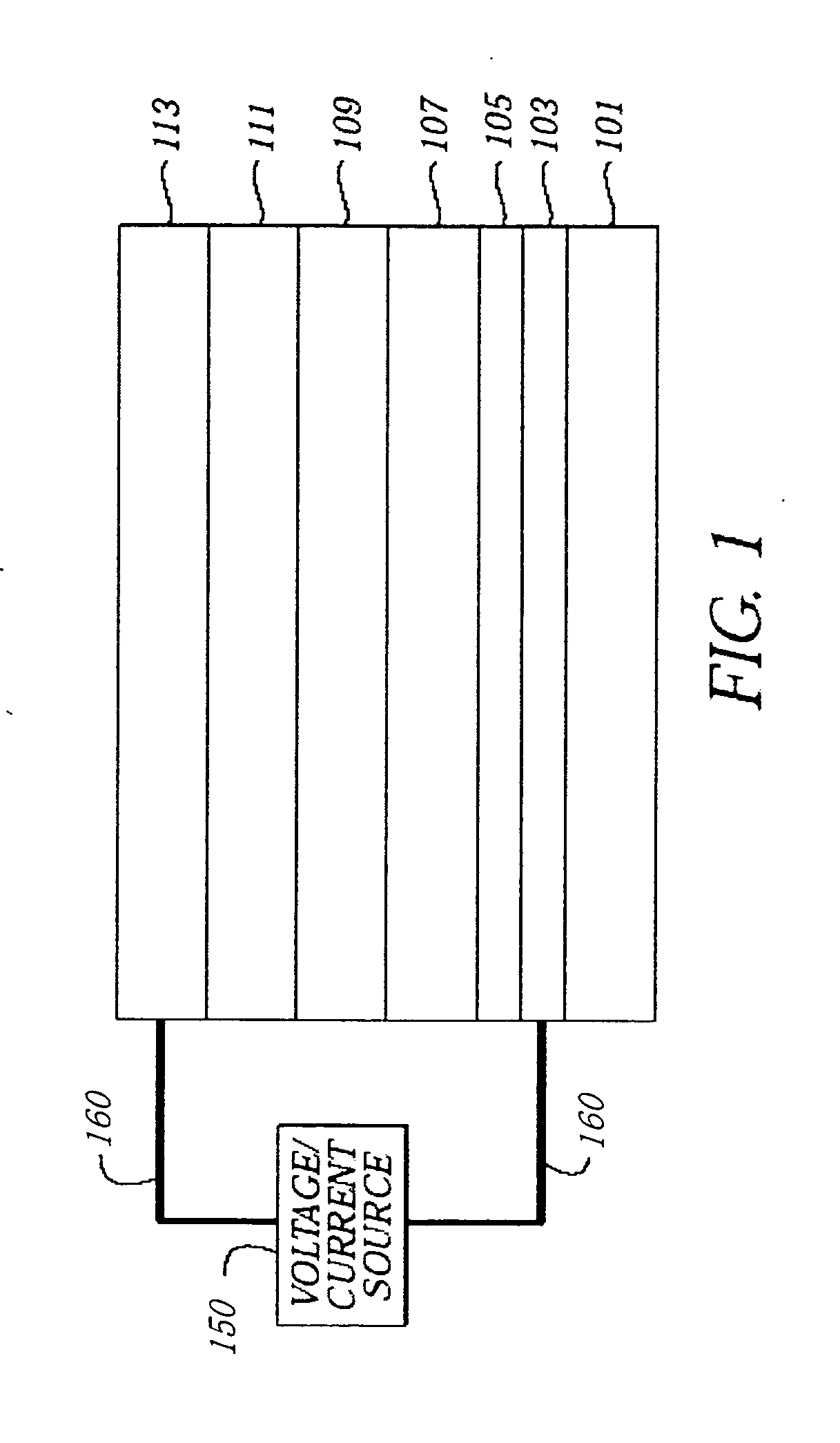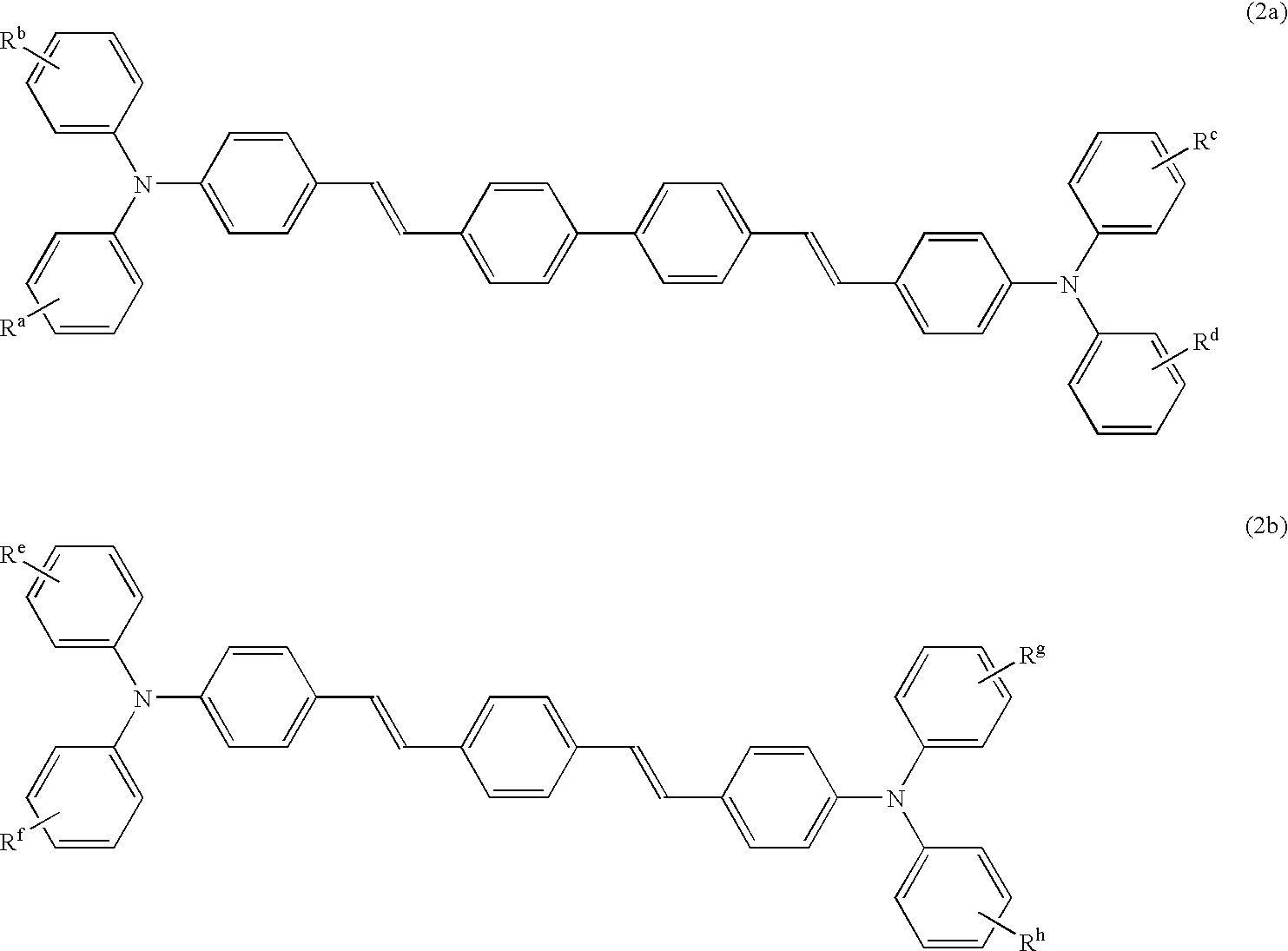White electroluminescent device with anthracene derivative host
an electroluminescent device and anthracene technology, applied in the field of white electroluminescent devices with anthracene derivative hosts, can solve the problems of difficult and expensive manufacture of anthracene substituted in such positions, not providing all desirable, and limiting the application of anthracene performance, etc., to achieve desirable hue, improve operational stability, and high luminance yield
- Summary
- Abstract
- Description
- Claims
- Application Information
AI Technical Summary
Benefits of technology
Problems solved by technology
Method used
Image
Examples
example 1
DEVICE EXAMPLE 1
EL Device Fabrication of Samples 1-6
[0157] An EL device (Sample 1) satisfying the requirements of the invention was constructed in the following manner: [0158] 1. A glass substrate coated with an 85 nm layer of indium-tin oxide (ITO) as the anode was sequentially ultrasonicated in a commercial detergent, rinsed in deionized water, degreased in toluene vapor and exposed to oxygen plasma for about 1 min. [0159] 2. Over the ITO was deposited a 1 nm fluorocarbon (CFx) hole-injecting layer (HIL) by plasma-assisted deposition of CHF3. [0160] 3. A hole-transporting layer (HTL) of N,N′-di-1-naphthyl-N,N-diphenyl-4,4′-diaminobiphenyl (NPB) having a thickness of 130 nm was then evaporated from a tantalum boat. [0161] 4. A 20 nm light-emitting layer (LEL), including host material NPB, and light-emitting material L54 (2.50 vol %), was then deposited onto the hole-transporting layer. These materials were also evaporated from tantalum boats. [0162] 5. A 40 nm light-emitting layer...
example 2
DEVICE EXAMPLE 2
EL Device Fabrication of Samples 7-12
[0169] EL devices, Samples 7-9, were fabricated in an identical manner as Samples 1-3, except TBP was replaced with light-emitting material L47, and the levels of L47 are indicated in Table 2. Comparison Samples 10-12 were prepared in the same manner as Samples 7-9 except host material Inv-1 was replaced by TBADN. The devices thus formed were tested in the same manner as Samples 1-6. The testing results are reported in Table 2.
TABLE 2Evaluation Results for EL devices 7-12.L47EfficiencyLevelYield200 hSampleHost(W / A)(vol %)(cd / A)CIExCIEyStabilityType7Inv-10.0682.008.260.3540.44990%Invention8Inv-10.0742.508.990.3490.45989%Invention9Inv-10.0703.008.650.3420.46987%Invention10TBADN0.0722.007.470.3120.37880%Comparison11TBADN0.0792.508.520.3070.40078%Comparison12TBADN0.0813.008.800.3040.40982%Comparison
[0170] It can be seen from Table 2 that Inv-1 in combination with L47 affords a good luminance yield at good operating efficiency and i...
example 3
DEVICE EXAMPLE 3
EL Device Fabrication of Samples 13-18
[0171] EL devices, Samples 13-15, were fabricated in an identical manner as Samples 1-3, except TBP was replaced with light-emitting material L53, and the level of L53 are indicated in Table 3. Comparison Samples 16-18 were prepared in the same manner as Samples 13-15 except host material Inv-1 was replaced by TBADN. The devices thus formed were tested in the same manner as Samples 1-6. The testing results are reported in Table 3.
TABLE 3Evaluation Results for EL devices 13-18.L53EfficiencyLevelYield200 hSampleHost(W / A)(vol %)(cd / A)CIExCIEyStabilityType13Inv-10.0330.503.600.3730.36595%Invention14Inv-10.0290.753.190.3610.36295%Invention15Inv-10.0301.253.160.3570.35398%Invention16TBADN0.0370.503.070.3020.26786%Comparison17TBADN0.0370.752.970.2880.25987%Comparison18TBADN0.0341.252.640.2690.24990%Comparison
[0172] It can be seen from Table 3 that Inv-1 in combination with L53 affords a good luminance yield at good operating efficien...
PUM
| Property | Measurement | Unit |
|---|---|---|
| Fraction | aaaaa | aaaaa |
| Fraction | aaaaa | aaaaa |
| Percent by mass | aaaaa | aaaaa |
Abstract
Description
Claims
Application Information
 Login to View More
Login to View More - R&D
- Intellectual Property
- Life Sciences
- Materials
- Tech Scout
- Unparalleled Data Quality
- Higher Quality Content
- 60% Fewer Hallucinations
Browse by: Latest US Patents, China's latest patents, Technical Efficacy Thesaurus, Application Domain, Technology Topic, Popular Technical Reports.
© 2025 PatSnap. All rights reserved.Legal|Privacy policy|Modern Slavery Act Transparency Statement|Sitemap|About US| Contact US: help@patsnap.com



